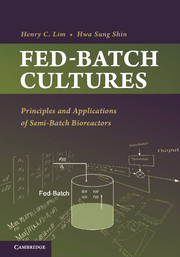Book contents
- Frontmatter
- Contents
- Preface
- Acknowledgments
- 1 Introduction to Fed-Batch Cultures
- 2 Idealized Reactors and Fed-Batch Reactors
- 3 Maximization of Reaction Rates and Fed-Batch Operation
- 4 Phenomena That Favor Fed-Batch Operations
- 5 Classification and Characteristics of Fed-Batch Cultures
- 6 Models Based on Mass Balance Equations
- 7 Non–Equation-Based Models
- 8 Specific Rate Determination
- 9 Optimization by Pontryagin's Maximum Principle
- 10 Computational Techniques
- 11 Optimization of Single and Multiple Reactions
- 12 Optimization for Cell Mass Production
- 13 Optimization for Metabolite Production
- 14 Simple Adaptive Optimization
- 15 Measurements, Estimation, and Control
- 16 Feasibility Assessment and Implementable Feed Rates
- Index
- References
5 - Classification and Characteristics of Fed-Batch Cultures
Published online by Cambridge University Press: 05 April 2013
- Frontmatter
- Contents
- Preface
- Acknowledgments
- 1 Introduction to Fed-Batch Cultures
- 2 Idealized Reactors and Fed-Batch Reactors
- 3 Maximization of Reaction Rates and Fed-Batch Operation
- 4 Phenomena That Favor Fed-Batch Operations
- 5 Classification and Characteristics of Fed-Batch Cultures
- 6 Models Based on Mass Balance Equations
- 7 Non–Equation-Based Models
- 8 Specific Rate Determination
- 9 Optimization by Pontryagin's Maximum Principle
- 10 Computational Techniques
- 11 Optimization of Single and Multiple Reactions
- 12 Optimization for Cell Mass Production
- 13 Optimization for Metabolite Production
- 14 Simple Adaptive Optimization
- 15 Measurements, Estimation, and Control
- 16 Feasibility Assessment and Implementable Feed Rates
- Index
- References
Summary
As for any reactor operation, the primary purpose of fed-batch operation is to maximize the rates of cell growth and product formation so that the total rate of product formation (productivity) or product yield (selectivity) is maximized. The desired product may be classified into (1) high volume–high margin products, (2) high volume–low margin products, (3) low volume–high margin products, and (4) low volume–low margin products. For high-margin products, the raw material cost may be negligible in comparison to the price of the product. In this case, there is little incentive to minimize the raw material cost. However, the production cost, which is roughly inversely proportional to the productivity, may be reduced by increasing the rate (productivity). For low-margin products, there is much incentive to minimize both the raw material and the processing costs.
For those processes for which the raw material is relatively inexpensive, one may wish to maximize the productivity (rate), while one may wish to improve the yield (selectivity) if the cost of the raw material and/or the product is relatively high. Ultimately, one must minimize the total production costs. This is achieved by regulating the feed rates of the limiting substrates, nitrogen and phosphate sources, inducers, precursors, or intermediates and by the selection of proper initial conditions. Through the manipulation of the feed rates of the medium containing the substrate and nutrients, the fed-batch operation allows regulation of the concentration of key substances that control the cell growth and/or product formation rate.
- Type
- Chapter
- Information
- Fed-Batch CulturesPrinciples and Applications of Semi-Batch Bioreactors, pp. 62 - 84Publisher: Cambridge University PressPrint publication year: 2013
References
- 2
- Cited by



